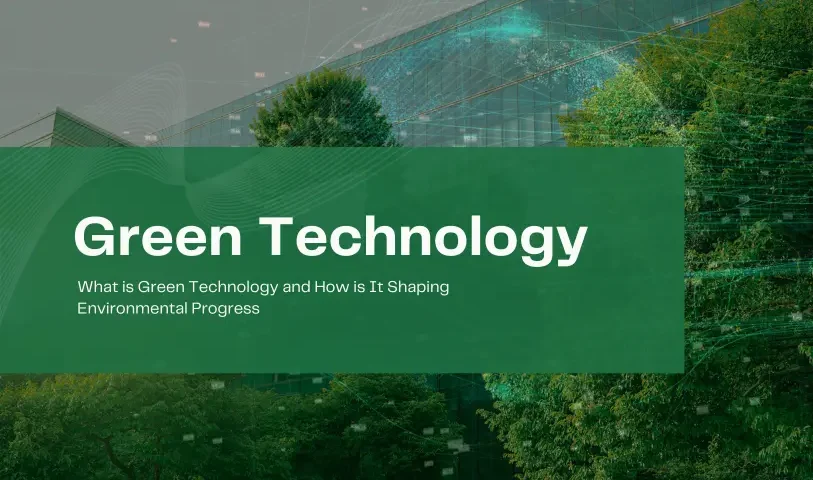What is Green Technology and How is It Shaping Environmental Progress

The Benefits of the Spiral Model for Complex Projects
April 3, 2025
How Generative AI is Transforming Industries in 2025
April 5, 2025In today’s world, where climate change and environmental degradation dominate global conversations, innovative solutions are more critical than ever. One such solution is green technology, a term that refers to the development and application of products, systems, and processes designed to minimize harm to the environment while promoting sustainability. From renewable energy sources to eco-friendly materials, green technology is paving the way for a cleaner, healthier planet. But what exactly does it entail, and how is it driving environmental progress? Let’s dive into this transformative concept and explore its impact.
Understanding Green Technology: A Simple Definition
At its core, green technology—sometimes called clean tech or environmental technology—focuses on creating sustainable alternatives to traditional practices that often deplete natural resources or pollute the environment. It encompasses a wide range of innovations, including solar panels, wind turbines, electric vehicles, and biodegradable packaging. The goal? To reduce carbon footprints, conserve energy, and protect ecosystems for future generations.
This field isn’t just about high-tech gadgets; it’s a mindset shift. It encourages industries, governments, and individuals to rethink how we produce, consume, and dispose of goods. By prioritizing efficiency and renewable resources, it offers a practical path toward balancing human needs with planetary health.
The Origins and Evolution of Green Technology
The roots of green technology stretch back decades, born out of growing awareness of environmental issues like air pollution, deforestation, and fossil fuel dependency. The 1970s energy crisis, for instance, sparked interest in solar and wind power as alternatives to oil. Since then, advancements in science and engineering have accelerated its growth, making it a cornerstone of modern sustainability efforts.
Today, this field is evolving rapidly. Innovations like carbon capture systems, which trap greenhouse gases before they enter the atmosphere, and smart grids, which optimize electricity distribution, showcase how far we’ve come. What started as a niche idea has become a global movement, influencing everything from urban planning to corporate strategies.
Key Areas Where Green Technology Shines
The scope of green technology is vast, touching nearly every aspect of life. Here are some of its most impactful applications:
Renewable Energy Solutions
Perhaps the most well-known example, renewable energy harnesses natural resources like sunlight, wind, and water to generate power. Solar farms and offshore wind turbines are reducing reliance on coal and gas, cutting emissions significantly. Countries like Germany and Denmark are leading the charge, proving that entire economies can thrive on clean energy.
Sustainable Transportation
Electric vehicles (EVs) and hydrogen-powered buses are revolutionizing how we move. By replacing gasoline engines with cleaner alternatives, these innovations slash air pollution in cities. Companies like Tesla and Rivian are pushing the boundaries, while public transit systems worldwide adopt greener fleets.
Waste Management Innovations
From recycling robots to composting systems, green technology is tackling the global waste crisis. Advanced sorting machines use AI to separate recyclables more efficiently, while biodegradable materials replace single-use plastics. These efforts reduce landfill overflow and marine pollution, protecting wildlife and ecosystems.
Eco-Friendly Construction
Buildings account for a huge chunk of global energy use. Green architecture counters this with energy-efficient designs, such as solar-powered homes and structures made from recycled materials. Techniques like green roofing—covering rooftops with plants—also help regulate temperatures and absorb rainwater.
How Green Technology Drives Environmental Progress
The beauty of green technology lies in its ability to address pressing environmental challenges head-on. Here’s how it’s making a difference:
Reducing Greenhouse Gas Emissions
Climate change, driven by carbon dioxide and methane emissions, is arguably the biggest threat to our planet. Clean energy solutions and efficient manufacturing processes are shrinking humanity’s carbon footprint. For example, a single wind turbine can offset thousands of tons of CO2 over its lifetime.
Conserving Natural Resources
Traditional industries often exploit finite resources like oil, coal, and timber. In contrast, sustainable innovations prioritize renewables and recycling. Water purification systems, for instance, turn wastewater into a reusable resource, easing pressure on freshwater supplies.
Restoring Ecosystems
Beyond prevention, some technologies actively heal damaged environments. Reforestation drones plant trees at scale, while ocean cleanup projects remove plastic from waterways. These efforts rebuild habitats and support biodiversity, offering hope for endangered species.
The Economic and Social Benefits
Environmental progress isn’t the only win here—green technology also boosts economies and communities. It creates millions of jobs, from engineers designing solar panels to technicians maintaining wind farms. According to recent studies, the renewable energy sector alone employs over 12 million people globally, with numbers climbing each year.
On the social front, cleaner air and water improve public health, reducing diseases linked to pollution. Affordable energy solutions also empower underserved regions, where access to electricity can transform education and livelihoods. It’s a ripple effect: sustainability lifts both people and the planet.
Challenges Facing Green Technology
Despite its promise, this field isn’t without hurdles. High upfront costs can deter adoption, especially in developing nations. For example, installing solar panels or building EV charging stations requires significant investment, even if the long-term savings are substantial.
There’s also the issue of scalability. While a single electric car helps, replacing entire fleets—or shifting whole industries to renewables—takes time and coordination. Plus, some solutions, like battery production, raise their own environmental concerns, such as mining for lithium.
Public perception and policy gaps add further complexity. Misinformation about costs or effectiveness can slow progress, while inconsistent regulations across countries create uneven playing fields. Overcoming these barriers requires collaboration between governments, businesses, and citizens.
The Future of Green Technology
Looking ahead, the potential is boundless. Emerging trends like artificial intelligence and nanotechnology could supercharge sustainability efforts. Imagine AI optimizing energy use in real-time or tiny robots cleaning pollutants from soil. These ideas, once science fiction, are inching closer to reality.
Investment is surging, too. Governments are rolling out incentives—like tax breaks for EV buyers—while private companies pour billions into research. By 2030, experts predict clean energy could dominate global power grids, a milestone that would reshape our environmental trajectory.
Why It Matters to You
So, why should the average person care? Because green technology isn’t just for scientists or policymakers—it’s for everyone. Small choices, like switching to LED bulbs or supporting eco-friendly brands, contribute to the bigger picture. Plus, as climate impacts like wildfires and floods grow more frequent, these innovations offer a lifeline.
On a personal level, adopting sustainable habits can save money and improve quality of life. Solar panels might cut your electric bill, while a cleaner environment means fewer health worries. It’s a win-win that starts with awareness and action.
Conclusion: A Greener Tomorrow Starts Today
Green technology is more than a buzzword—it’s a revolution reshaping how we interact with our planet. By cutting emissions, conserving resources, and fostering innovation, it’s driving environmental progress at an unprecedented pace. While challenges remain, the momentum is undeniable. From towering wind turbines to compostable coffee cups, these solutions prove that a sustainable future isn’t just possible—it’s already underway. The question is, how will you join the movement?


